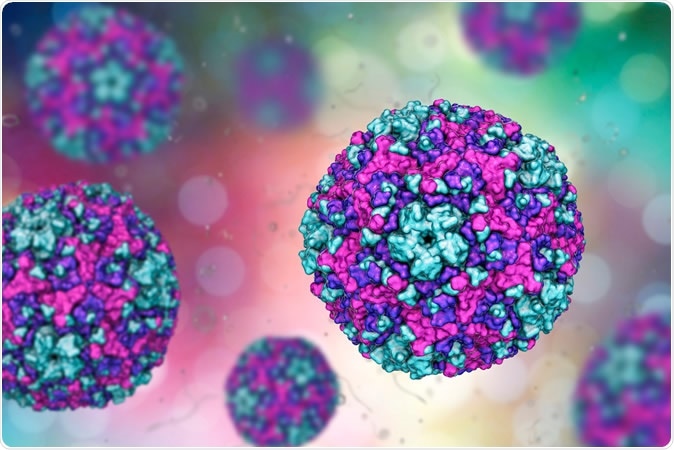HFMD is a public health problem that is threatening to become a significant issue among children in East and Southeast Asia. The condition is an acute infection caused by an enterovirus of the picornavirus family. It is usually seen to affect infants as well as children below five years of age. It is contagious, spreading between children with ease. Though it is usually self-limiting, resolving within a few weeks, in some cases, it can cause meningitis and encephalitis of the hindbrain. The outcome in such cases may be paralysis, lung and heart complications, or death.
The more severe and complicated cases are seen to occur with the strain of a virus called EV-A71. Other commonly isolated viruses include the coxsackievirus A16 (CV-A16) and CV-A6.

Coxsackievirus, 3D illustration. RNA virus from Picornaviridae family, the genus Enterovirus, causes hand, foot and mouth disease, meningitis, myocarditis, acute hemorrhagic conjunctivitis. Image Credit: Kateryna Kon / Shutterstock
Scientists are working on producing a live attenuated vaccine against the virus because the current inactivated viral vaccine is not as effective as it could be. The newly emerging C4 strains are being examined to find the one which is most appropriate for a better vaccine. This is all the more relevant in that there is no antiviral drug that can be reliably used to counteract the disease caused by EV-A71.
How was the study carried out?
The strains that caused an outbreak of HFMD in northern Vietnam in 2015-16 were isolated from the throat and rectal swabs collected from almost 490 children with the sickness in Hanoi. The researchers aimed to explore the epidemiology of the illness.
Of the approximately 490 patients, about 442 were positive for the virus. On gene analysis, the partial VP1 gene analysis was successful in about 390 children. The viruses included 15 types of enterovirus, including CV-A6 and EV-A71. There were 127 strains of EV-A71.
Of these, the more significant number (117/127) was of the B5 subgenotype, and 10 were C4. Among these, 7 of 8 C4a isolates were part of a new lineage. Two of these appeared to be possibly recombination between EV-A71 C4 and CV-A8.
The investigators looked at how many of the children with the illness had to be hospitalized – this indicated the virulence of the virus because EV-A71 is more virulent to the brain and spinal cord compared to the A strains that affect other species. Children with EV-A71 were admitted twice as often (32% vs. 15%) than those with CV-A6. When the children with the former strain of virus were further broken up by subgenotype, it was found that those with C4 infection were markedly more likely to be hospitalized than those with B5. The researchers inferred that this showed the greater virulence of the former subtype. However, the number of patients with C4 infection was low.
Modeling in mice
This led them to confirm their earlier findings using a second technique. They used a transgenic mouse model that could be infected with EV-A71. This is due to the presence of the human scavenger receptor B class 2 (hSCARB2), which confers susceptibility to several HFMD-causing viruses, including EV-A71, CV-A16, CV-A14, and CV-A7. This avoids bias due to environmental and host factors.
They inoculated the hSCARB2 mice with the virus. In 19 cases, the B5 strains were used, and in 8, C4 strains. They then monitored the animals to see if they fell sick. The features looked for included weakness of the limbs, acute flaccid paralysis (AFP), loss of weight, and death.
These features began to be manifested within a week of infection, mostly wobbling and AFP. Some mice died or were killed to put an end to their pain. In infection caused by either strain, the clinical features were apparently identical. However, the rate of mortality was noticeably higher among the mice inoculated with the C4 strains compared to the B5 strains. An insignificant increase in rates of paralysis among the former mice was also observed at 90% vs. 70%.
There was also no significant difference in the death rates and paralysis rates between either grade I and grade II clinical features. These were taken to indicate infected children with mild disease, requiring outpatient care (grade I), and those who required admission (grade II), respectively.
Researcher Kyousuke Kobayashi explains the findings, “We found increased paralysis and significantly higher mortality among mice infected with C4 strains than those infected with B5 strains.”
The take-home
The Vietnamese epidemic showed a shift from the enterovirus A71 C5 strain to C4 in 2011. The period 2011-12 reported the largest outbreak with an increased number of severely ill people. The number of cases and serious illnesses were both reported to be declining in 2013, and the dominant subtype appeared to shift from C4 to B5. The current study, however, shows that most severe cases were caused by the C4a strain. This may indicate another shift in dominant strain to a possibly more virulent lineage, which may cause a more serious outbreak.
Journal reference:
Chu, S. T., et al. (2020). Newly Emerged Enterovirus-A71 C4 Sublineage May Be More Virulent Than B5 In The 2015–2016 Hand-Foot-And-Mouth Disease Outbreak in Northern Vietnam. Scientific Reports volume 10, Article number: 159 (2020). https://doi.org/10.1038/s41598-019-56703-5. https://www.nature.com/articles/s41598-019-56703-5